Cultural Essay: Analyzing Social Relations in a Heroin Marketplace
VerifiedAdded on 2023/04/20
|7
|1299
|169
Essay
AI Summary
This essay provides an outline for a critical analysis of a case study focusing on the social dynamics of heroin exchange in a marketplace, drawing primarily from Dwyer's ethnographic study 'The Social Life of Smokes.' It examines how social relationships, cultural perceptions, and power dynamics influence drug exchanges. The essay also considers opposing viewpoints, such as the role of social support in drug addiction recovery, and explores other factors beyond social relationships, including socioeconomic status and cultural symbolism, that contribute to drug usage. Ultimately, it concludes that heroin exchange is a complex interplay of social relationships and cultural perceptions, while acknowledging the potential for social support in addiction recovery.
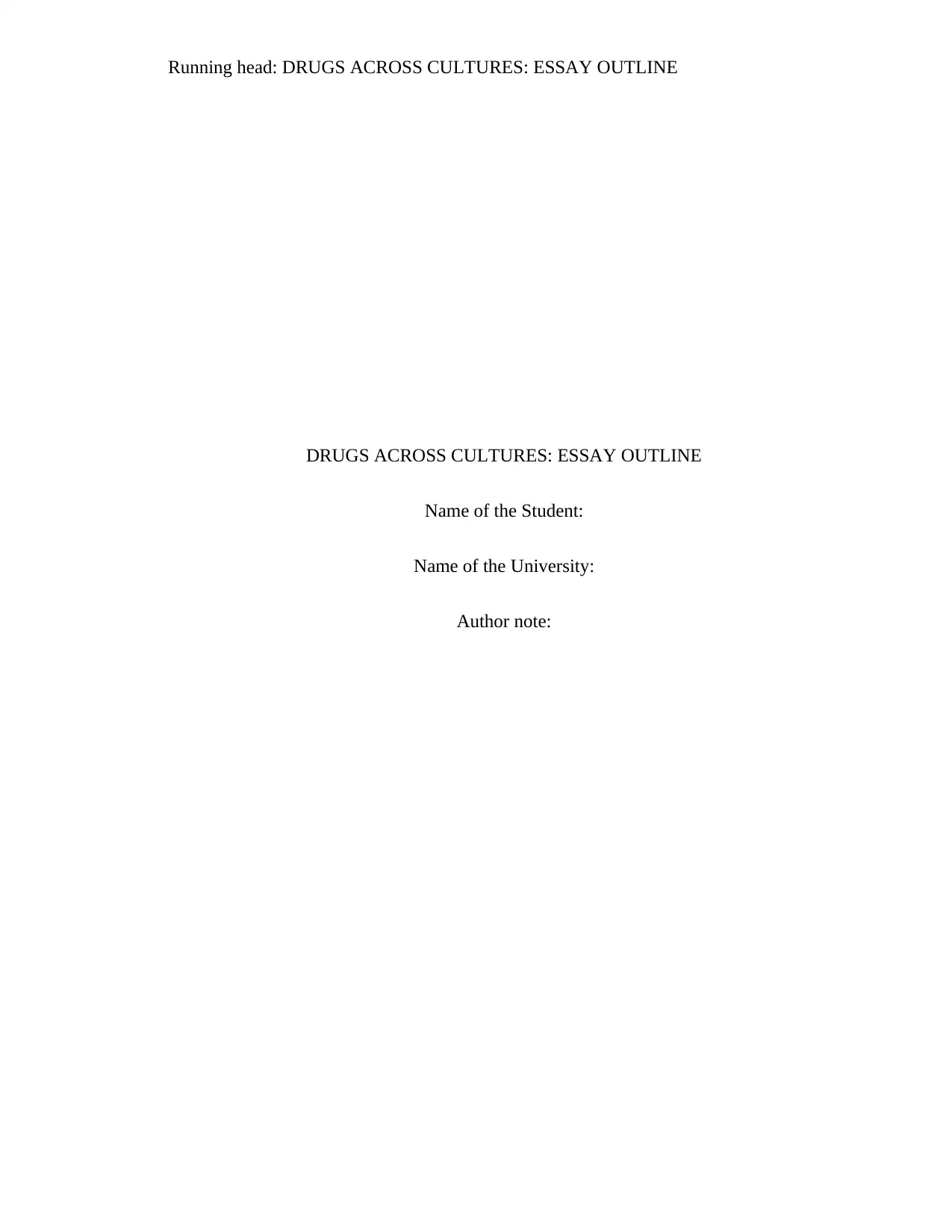
Running head: DRUGS ACROSS CULTURES: ESSAY OUTLINE
DRUGS ACROSS CULTURES: ESSAY OUTLINE
Name of the Student:
Name of the University:
Author note:
DRUGS ACROSS CULTURES: ESSAY OUTLINE
Name of the Student:
Name of the University:
Author note:
Paraphrase This Document
Need a fresh take? Get an instant paraphrase of this document with our AI Paraphraser
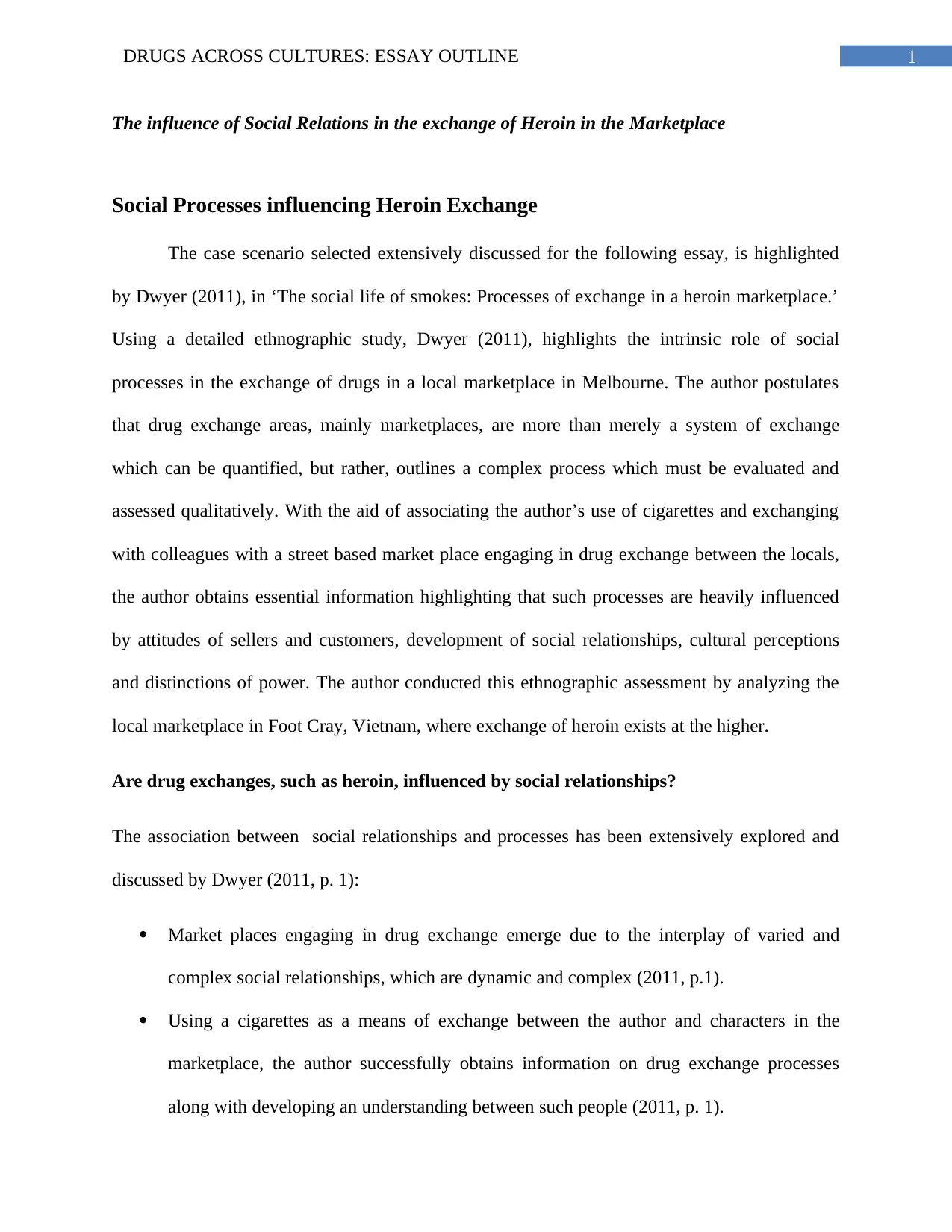
1DRUGS ACROSS CULTURES: ESSAY OUTLINE
The influence of Social Relations in the exchange of Heroin in the Marketplace
Social Processes influencing Heroin Exchange
The case scenario selected extensively discussed for the following essay, is highlighted
by Dwyer (2011), in ‘The social life of smokes: Processes of exchange in a heroin marketplace.’
Using a detailed ethnographic study, Dwyer (2011), highlights the intrinsic role of social
processes in the exchange of drugs in a local marketplace in Melbourne. The author postulates
that drug exchange areas, mainly marketplaces, are more than merely a system of exchange
which can be quantified, but rather, outlines a complex process which must be evaluated and
assessed qualitatively. With the aid of associating the author’s use of cigarettes and exchanging
with colleagues with a street based market place engaging in drug exchange between the locals,
the author obtains essential information highlighting that such processes are heavily influenced
by attitudes of sellers and customers, development of social relationships, cultural perceptions
and distinctions of power. The author conducted this ethnographic assessment by analyzing the
local marketplace in Foot Cray, Vietnam, where exchange of heroin exists at the higher.
Are drug exchanges, such as heroin, influenced by social relationships?
The association between social relationships and processes has been extensively explored and
discussed by Dwyer (2011, p. 1):
Market places engaging in drug exchange emerge due to the interplay of varied and
complex social relationships, which are dynamic and complex (2011, p.1).
Using a cigarettes as a means of exchange between the author and characters in the
marketplace, the author successfully obtains information on drug exchange processes
along with developing an understanding between such people (2011, p. 1).
The influence of Social Relations in the exchange of Heroin in the Marketplace
Social Processes influencing Heroin Exchange
The case scenario selected extensively discussed for the following essay, is highlighted
by Dwyer (2011), in ‘The social life of smokes: Processes of exchange in a heroin marketplace.’
Using a detailed ethnographic study, Dwyer (2011), highlights the intrinsic role of social
processes in the exchange of drugs in a local marketplace in Melbourne. The author postulates
that drug exchange areas, mainly marketplaces, are more than merely a system of exchange
which can be quantified, but rather, outlines a complex process which must be evaluated and
assessed qualitatively. With the aid of associating the author’s use of cigarettes and exchanging
with colleagues with a street based market place engaging in drug exchange between the locals,
the author obtains essential information highlighting that such processes are heavily influenced
by attitudes of sellers and customers, development of social relationships, cultural perceptions
and distinctions of power. The author conducted this ethnographic assessment by analyzing the
local marketplace in Foot Cray, Vietnam, where exchange of heroin exists at the higher.
Are drug exchanges, such as heroin, influenced by social relationships?
The association between social relationships and processes has been extensively explored and
discussed by Dwyer (2011, p. 1):
Market places engaging in drug exchange emerge due to the interplay of varied and
complex social relationships, which are dynamic and complex (2011, p.1).
Using a cigarettes as a means of exchange between the author and characters in the
marketplace, the author successfully obtains information on drug exchange processes
along with developing an understanding between such people (2011, p. 1).
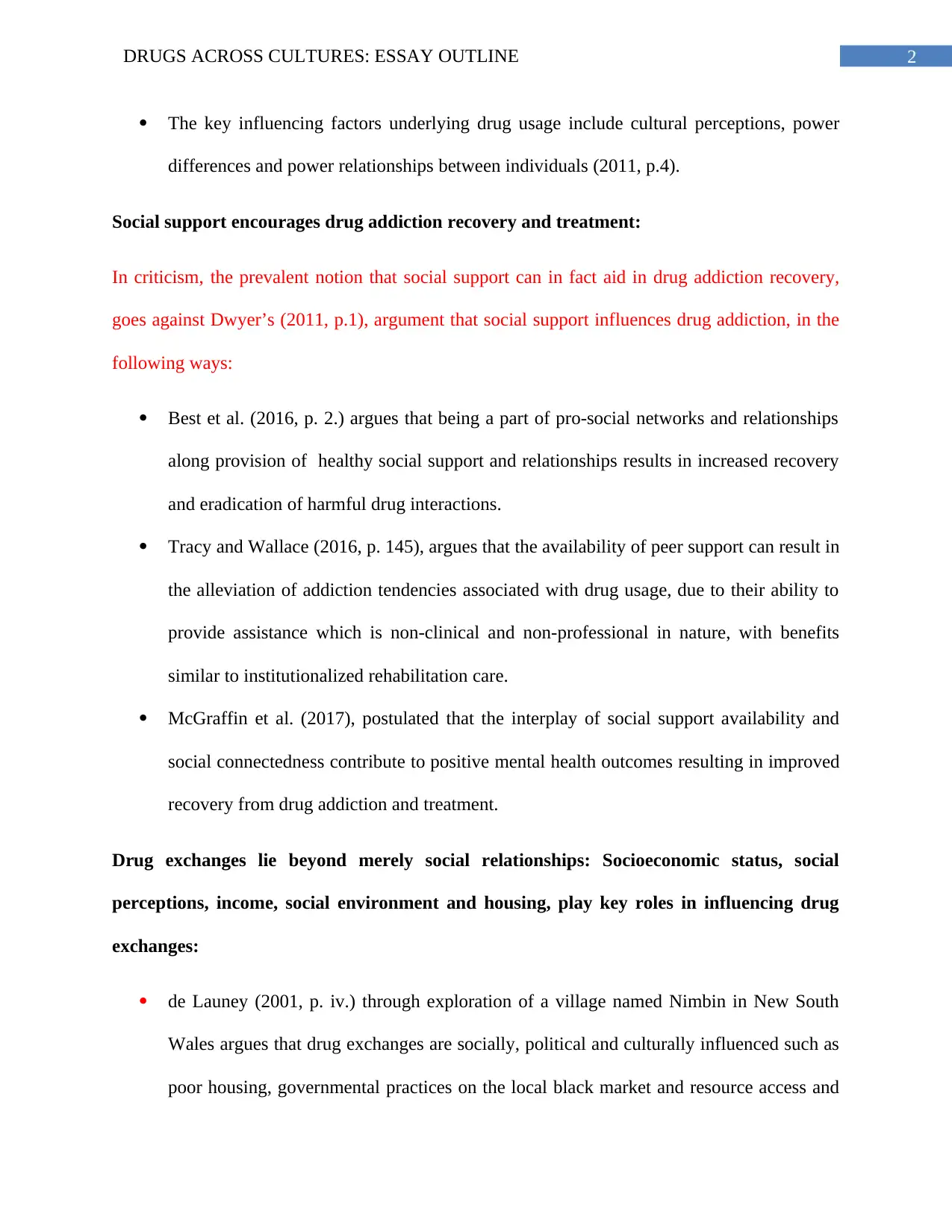
2DRUGS ACROSS CULTURES: ESSAY OUTLINE
The key influencing factors underlying drug usage include cultural perceptions, power
differences and power relationships between individuals (2011, p.4).
Social support encourages drug addiction recovery and treatment:
In criticism, the prevalent notion that social support can in fact aid in drug addiction recovery,
goes against Dwyer’s (2011, p.1), argument that social support influences drug addiction, in the
following ways:
Best et al. (2016, p. 2.) argues that being a part of pro-social networks and relationships
along provision of healthy social support and relationships results in increased recovery
and eradication of harmful drug interactions.
Tracy and Wallace (2016, p. 145), argues that the availability of peer support can result in
the alleviation of addiction tendencies associated with drug usage, due to their ability to
provide assistance which is non-clinical and non-professional in nature, with benefits
similar to institutionalized rehabilitation care.
McGraffin et al. (2017), postulated that the interplay of social support availability and
social connectedness contribute to positive mental health outcomes resulting in improved
recovery from drug addiction and treatment.
Drug exchanges lie beyond merely social relationships: Socioeconomic status, social
perceptions, income, social environment and housing, play key roles in influencing drug
exchanges:
de Launey (2001, p. iv.) through exploration of a village named Nimbin in New South
Wales argues that drug exchanges are socially, political and culturally influenced such as
poor housing, governmental practices on the local black market and resource access and
The key influencing factors underlying drug usage include cultural perceptions, power
differences and power relationships between individuals (2011, p.4).
Social support encourages drug addiction recovery and treatment:
In criticism, the prevalent notion that social support can in fact aid in drug addiction recovery,
goes against Dwyer’s (2011, p.1), argument that social support influences drug addiction, in the
following ways:
Best et al. (2016, p. 2.) argues that being a part of pro-social networks and relationships
along provision of healthy social support and relationships results in increased recovery
and eradication of harmful drug interactions.
Tracy and Wallace (2016, p. 145), argues that the availability of peer support can result in
the alleviation of addiction tendencies associated with drug usage, due to their ability to
provide assistance which is non-clinical and non-professional in nature, with benefits
similar to institutionalized rehabilitation care.
McGraffin et al. (2017), postulated that the interplay of social support availability and
social connectedness contribute to positive mental health outcomes resulting in improved
recovery from drug addiction and treatment.
Drug exchanges lie beyond merely social relationships: Socioeconomic status, social
perceptions, income, social environment and housing, play key roles in influencing drug
exchanges:
de Launey (2001, p. iv.) through exploration of a village named Nimbin in New South
Wales argues that drug exchanges are socially, political and culturally influenced such as
poor housing, governmental practices on the local black market and resource access and
⊘ This is a preview!⊘
Do you want full access?
Subscribe today to unlock all pages.

Trusted by 1+ million students worldwide

3DRUGS ACROSS CULTURES: ESSAY OUTLINE
cultural opinions on drug usage and the influence of drugs in daily lives of citizens. Such
similarities can be found extensively in Dwyer’s (2011, p. 4) exploration of the
impoverished Vietnamese locals delving in drug exchanges in the Foot Cray market.
As supported by Himmeslstein (1983, pp.14), the usage of drugs like marijuana has
increased alarmingly, due to the changing political scenario surrounding drug usage,
social perceptions underlying drug users and increased attachment of the drug to
symbolism. Similarly, social attachment can be observed in the drug exchangers referring
to Dwyer (2011, p. 3), as ‘elder sister’, merely over an exchange of cigarettes.
Increased drug usage can be associated with a desire to achieve an ‘altered
consciousness’ and the social perception that an escape for the harsh realities of daily life
is acceptable, as postulated by Robson (1999, p. 5).
As noted in the research of drug usage among indigenous communities in the Amazon by
Weil (1973, p. 101), the usage and access of drugs are considered as socially acceptable
due to the permitted perceptions that escaping or delving into a state of consciousness is
natural and even celebrated. Similarly, Dwyer (2011, p.3.) observed that drug exchanges
are considered socially acceptable products of social relationships between individuals.
Conclusion
Hence, it can be concluded that the supply, exchange and usage of drugs such as heroin
among individuals are a result of the complex social relationships as well as personal cultural
perceptions that exist between individuals. However, it can be argued that, social support can
encourage people in their path to a hastened recovery from addictions and drug usage.. However,
in criticism, social relationships influencing drug exchanges may be more complex in nature
cultural opinions on drug usage and the influence of drugs in daily lives of citizens. Such
similarities can be found extensively in Dwyer’s (2011, p. 4) exploration of the
impoverished Vietnamese locals delving in drug exchanges in the Foot Cray market.
As supported by Himmeslstein (1983, pp.14), the usage of drugs like marijuana has
increased alarmingly, due to the changing political scenario surrounding drug usage,
social perceptions underlying drug users and increased attachment of the drug to
symbolism. Similarly, social attachment can be observed in the drug exchangers referring
to Dwyer (2011, p. 3), as ‘elder sister’, merely over an exchange of cigarettes.
Increased drug usage can be associated with a desire to achieve an ‘altered
consciousness’ and the social perception that an escape for the harsh realities of daily life
is acceptable, as postulated by Robson (1999, p. 5).
As noted in the research of drug usage among indigenous communities in the Amazon by
Weil (1973, p. 101), the usage and access of drugs are considered as socially acceptable
due to the permitted perceptions that escaping or delving into a state of consciousness is
natural and even celebrated. Similarly, Dwyer (2011, p.3.) observed that drug exchanges
are considered socially acceptable products of social relationships between individuals.
Conclusion
Hence, it can be concluded that the supply, exchange and usage of drugs such as heroin
among individuals are a result of the complex social relationships as well as personal cultural
perceptions that exist between individuals. However, it can be argued that, social support can
encourage people in their path to a hastened recovery from addictions and drug usage.. However,
in criticism, social relationships influencing drug exchanges may be more complex in nature
Paraphrase This Document
Need a fresh take? Get an instant paraphrase of this document with our AI Paraphraser
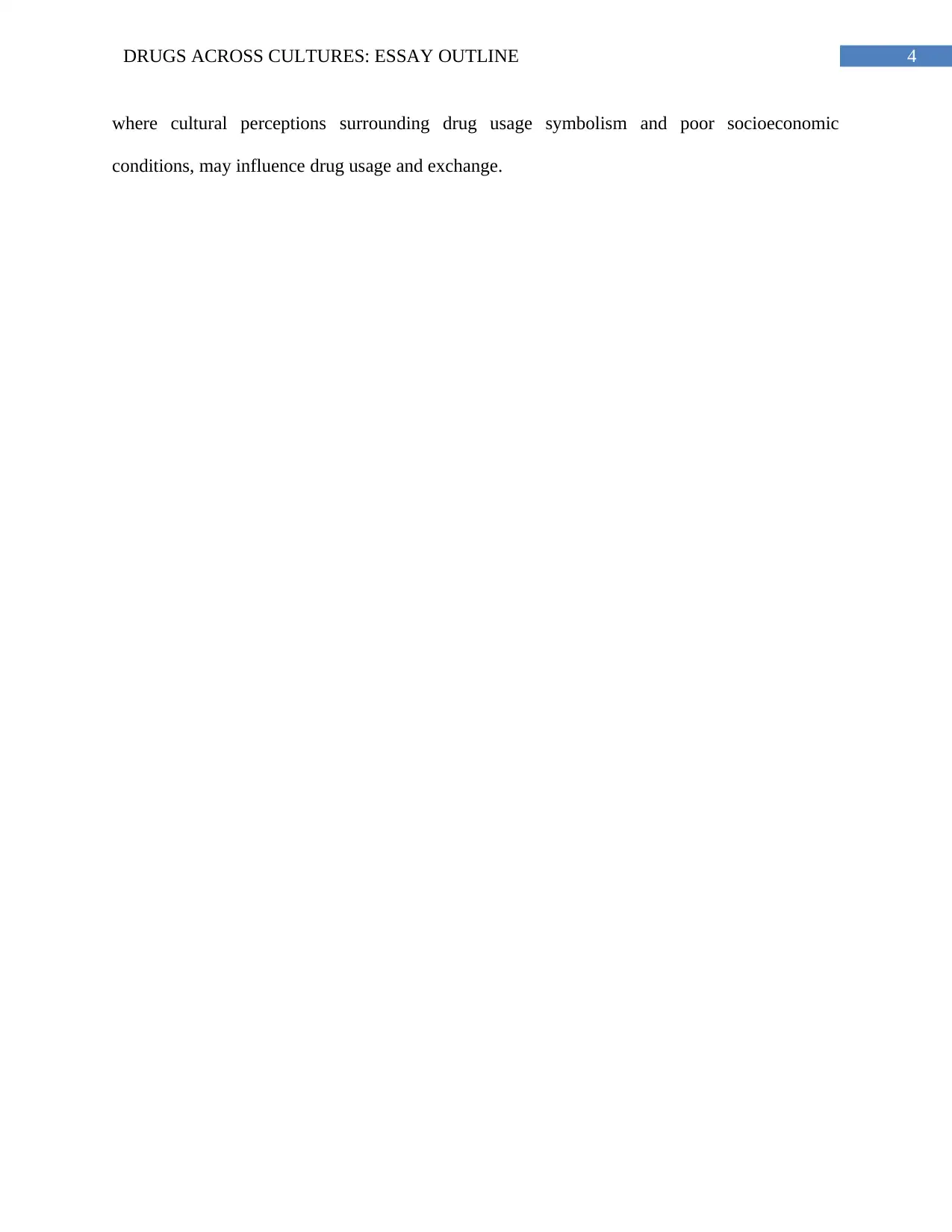
4DRUGS ACROSS CULTURES: ESSAY OUTLINE
where cultural perceptions surrounding drug usage symbolism and poor socioeconomic
conditions, may influence drug usage and exchange.
where cultural perceptions surrounding drug usage symbolism and poor socioeconomic
conditions, may influence drug usage and exchange.
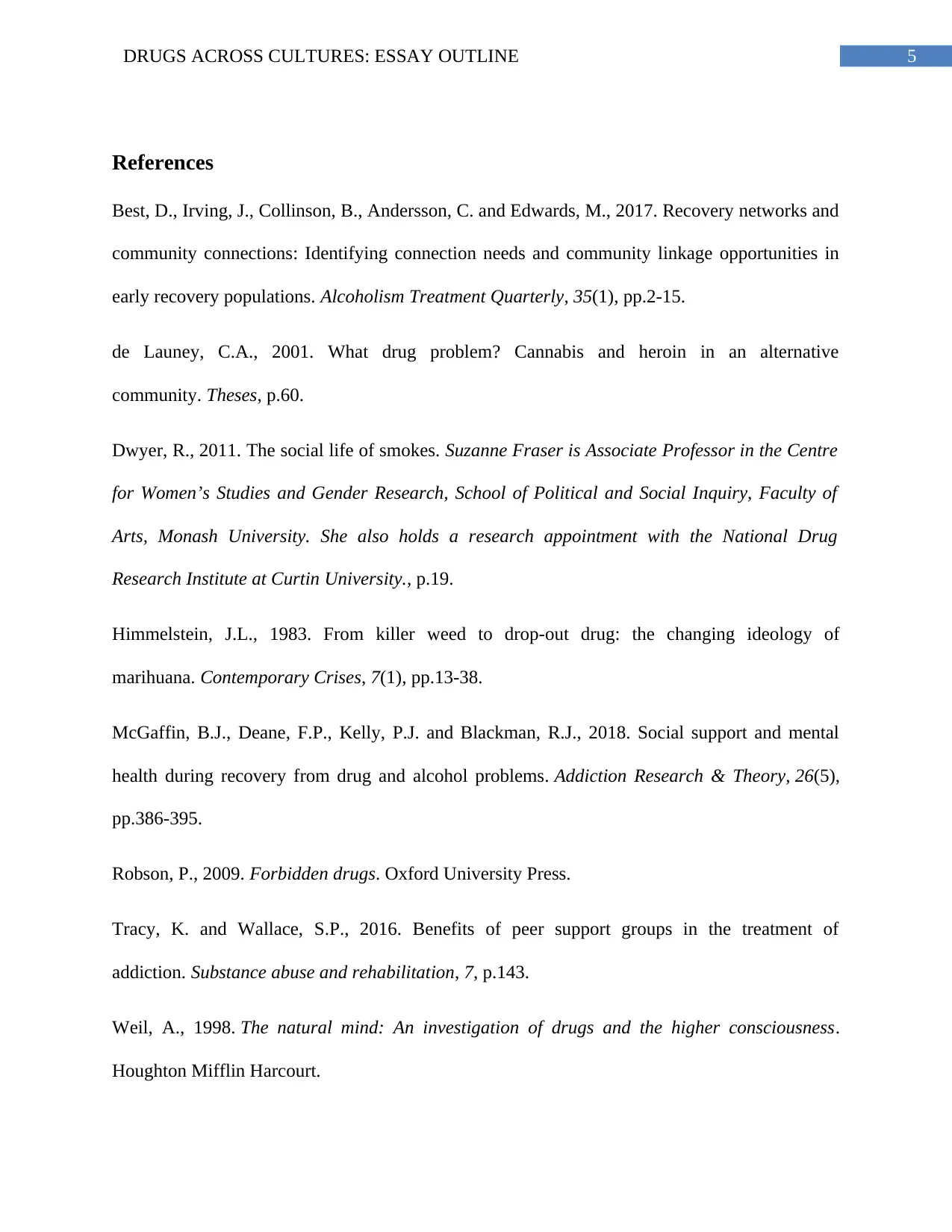
5DRUGS ACROSS CULTURES: ESSAY OUTLINE
References
Best, D., Irving, J., Collinson, B., Andersson, C. and Edwards, M., 2017. Recovery networks and
community connections: Identifying connection needs and community linkage opportunities in
early recovery populations. Alcoholism Treatment Quarterly, 35(1), pp.2-15.
de Launey, C.A., 2001. What drug problem? Cannabis and heroin in an alternative
community. Theses, p.60.
Dwyer, R., 2011. The social life of smokes. Suzanne Fraser is Associate Professor in the Centre
for Women’s Studies and Gender Research, School of Political and Social Inquiry, Faculty of
Arts, Monash University. She also holds a research appointment with the National Drug
Research Institute at Curtin University., p.19.
Himmelstein, J.L., 1983. From killer weed to drop-out drug: the changing ideology of
marihuana. Contemporary Crises, 7(1), pp.13-38.
McGaffin, B.J., Deane, F.P., Kelly, P.J. and Blackman, R.J., 2018. Social support and mental
health during recovery from drug and alcohol problems. Addiction Research & Theory, 26(5),
pp.386-395.
Robson, P., 2009. Forbidden drugs. Oxford University Press.
Tracy, K. and Wallace, S.P., 2016. Benefits of peer support groups in the treatment of
addiction. Substance abuse and rehabilitation, 7, p.143.
Weil, A., 1998. The natural mind: An investigation of drugs and the higher consciousness.
Houghton Mifflin Harcourt.
References
Best, D., Irving, J., Collinson, B., Andersson, C. and Edwards, M., 2017. Recovery networks and
community connections: Identifying connection needs and community linkage opportunities in
early recovery populations. Alcoholism Treatment Quarterly, 35(1), pp.2-15.
de Launey, C.A., 2001. What drug problem? Cannabis and heroin in an alternative
community. Theses, p.60.
Dwyer, R., 2011. The social life of smokes. Suzanne Fraser is Associate Professor in the Centre
for Women’s Studies and Gender Research, School of Political and Social Inquiry, Faculty of
Arts, Monash University. She also holds a research appointment with the National Drug
Research Institute at Curtin University., p.19.
Himmelstein, J.L., 1983. From killer weed to drop-out drug: the changing ideology of
marihuana. Contemporary Crises, 7(1), pp.13-38.
McGaffin, B.J., Deane, F.P., Kelly, P.J. and Blackman, R.J., 2018. Social support and mental
health during recovery from drug and alcohol problems. Addiction Research & Theory, 26(5),
pp.386-395.
Robson, P., 2009. Forbidden drugs. Oxford University Press.
Tracy, K. and Wallace, S.P., 2016. Benefits of peer support groups in the treatment of
addiction. Substance abuse and rehabilitation, 7, p.143.
Weil, A., 1998. The natural mind: An investigation of drugs and the higher consciousness.
Houghton Mifflin Harcourt.
⊘ This is a preview!⊘
Do you want full access?
Subscribe today to unlock all pages.

Trusted by 1+ million students worldwide

6DRUGS ACROSS CULTURES: ESSAY OUTLINE
1 out of 7
Related Documents
Your All-in-One AI-Powered Toolkit for Academic Success.
+13062052269
info@desklib.com
Available 24*7 on WhatsApp / Email
![[object Object]](/_next/static/media/star-bottom.7253800d.svg)
Unlock your academic potential
Copyright © 2020–2025 A2Z Services. All Rights Reserved. Developed and managed by ZUCOL.





